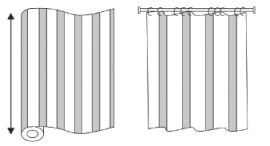Fabric FAQs
-
What do the different ‘pattern matches’ mean?
- ‘Half Drop’ repeat is where every other horizontal repeat (from side to side) is dropped down one half of its length, i.e. the design repeats itself on the diagonal rather than the horizontal axis.
- ‘Straight Match’ is where the pattern repeats across the full width of the fabric and is positioned at the same place at each selvedge.
-‘Random Match’ is where there is no pattern match. -
What does the term ‘railroaded’ mean?
Railroaded is the term used for fabric patterns/designs that are printed or woven across the width of the fabric, instead of vertically down the length of the fabric. Normally, fabrics are printed or woven so the design runs vertically through the length of the fabric. By railroading the pattern/design it is turned 90 degrees to enable the width (selvedge to selvedge) to be used as the drop.
The benefit of railroading wide width fabrics is that any width of curtain can be made without the need for joining multiple widths. Noting that the maximum drop will be the width of the fabric less an allowance for the header and hem.
-
What does ‘Martindale Abrasion’ mean?
The Martindale Abrasion Test is the measure of the wear on the surface of a fabric or textile while rubbing it with another material. The results of this test contribute to the assessment of the “End Usage” suitability of a fabric. The Martindale abrasion test takes a sample of the fabric and rubs it against an abrasive material, undergoing several assessments. The test is stopped when the specified number of threads are broken, or sufficient pile is removed from a velvet. The end point results are shown in 000’s rubs. The higher the result the better the durability. The British classification standard BS2543:2004 for upholstery fabrics, specifies the criteria for end usage i.e., Occasional domestic upholstery through to Severe Contract upholstery as below:Occasional Domestic Upholstery Light Domestic Upholstery General Domestic Upholstery Heavy Domestic Upholstery General Contract Upholstery Severe Contract Upholstery 6000 (Min) 15000 (Flat) 20000 (Flat) 25000 (Flat) 30000 (Flat) 40000 (Flat) 6000 (Min) 12000 (Figd) 15000 (Figd) 20000 (Figd) 30000 (Figd) 40000 (Figd) 6000 (Min) 15000 (Pile-Flock) 20000 (Pile-Flock) 25000 (Pile-Flock) 25000 (Pile-Flock) 30000 (Pile-Flock) -
How are wide width fabrics shipped?
Orders exceeding 20m of wide width fabric will be dispatched on 3m wide poles. -
Do the fire treated properties of a fabric reduce with cleaning? How would you recommend cleaning fire treated fabric?
When we treat here in the UK for upholstery or drapery standards, the fabric should be maintained by dry cleaning. The FR treatment is guaranteed for four years, or 5 dry cleans, whichever is the sooner. For fixed upholstery, we would recommend a professional upholstery dry cleaner to visit in situ. Where this is not possible, we recommend the below:
- Vacuum regularly to prevent the build-up of dirt. (build-up of dirt can reduce the effectiveness of the stain resist).
- For spillages - wipe clean using a microfiber cloth or sponge with warm water taking care not to damage the fabric surface.
- For more stubborn stains use mild soap solution but ensure you rinse thoroughly leaving no soap residue. -
Can your fabrics be used in a bathroom?
Due to moisture that may be present within a bathroom, we would suggest that a machine washable fabric is selected for this use.





